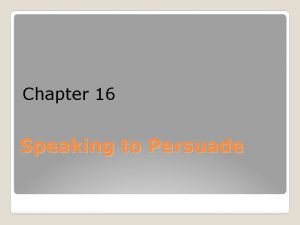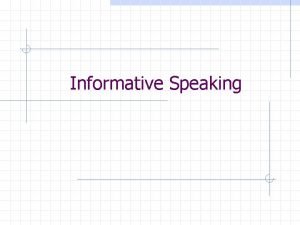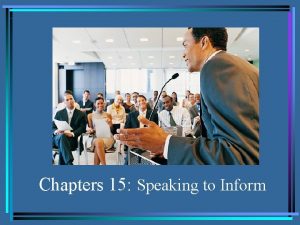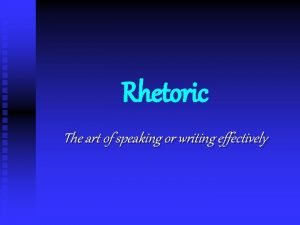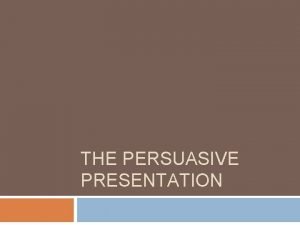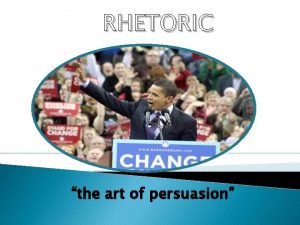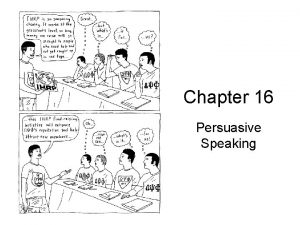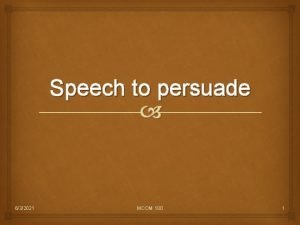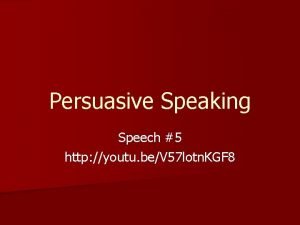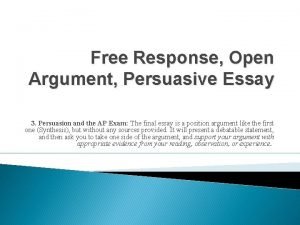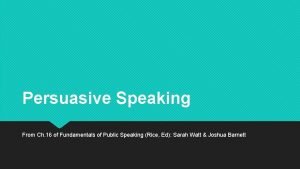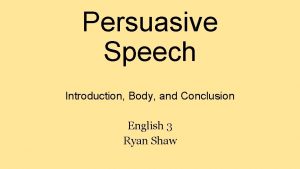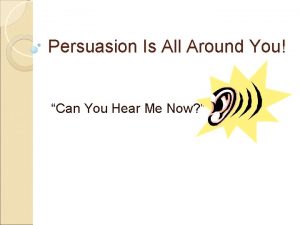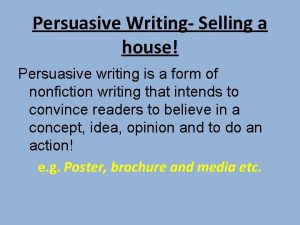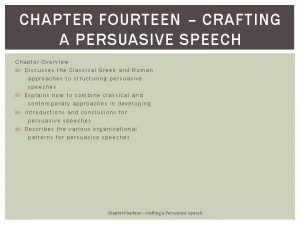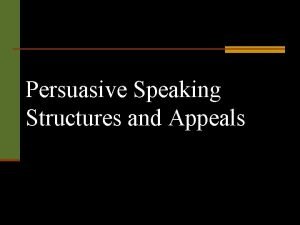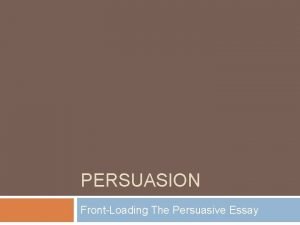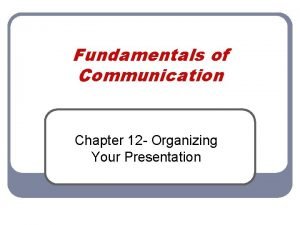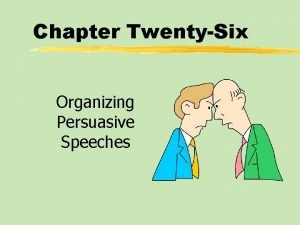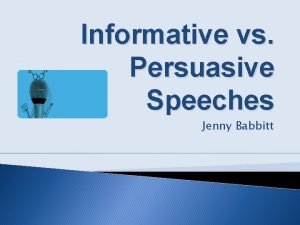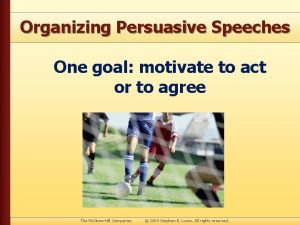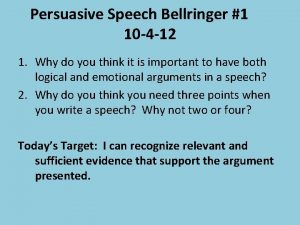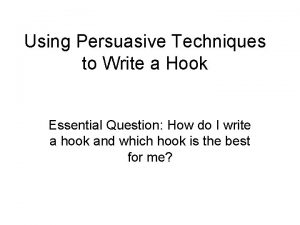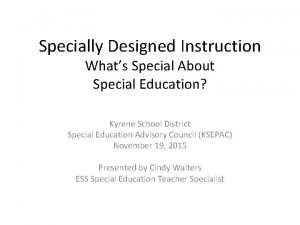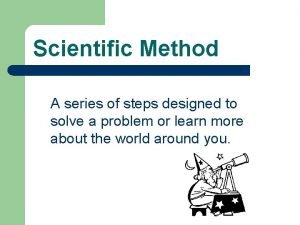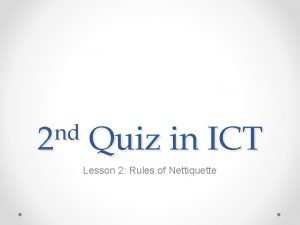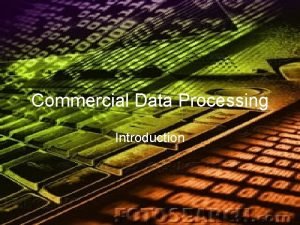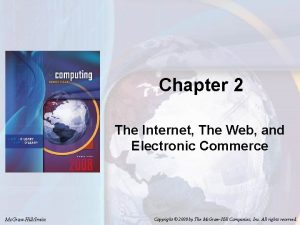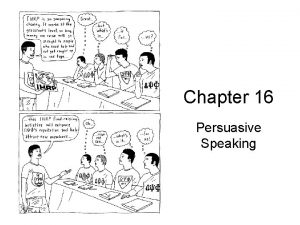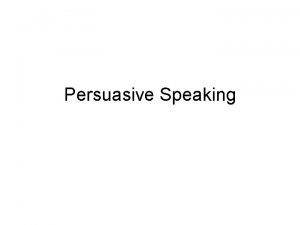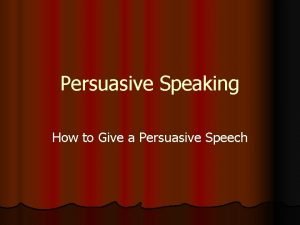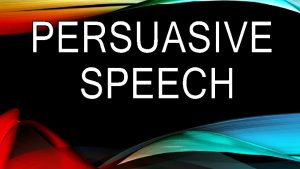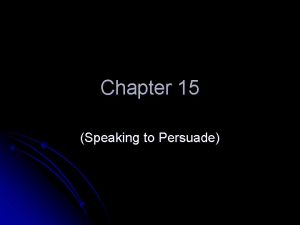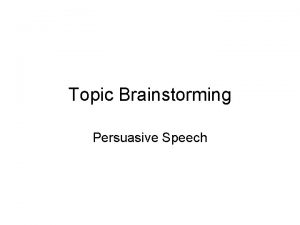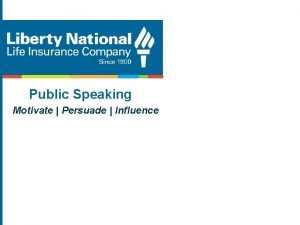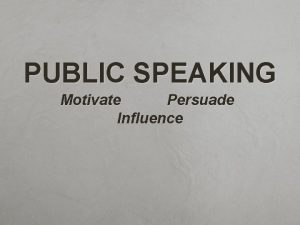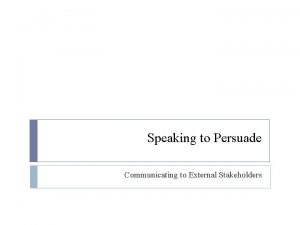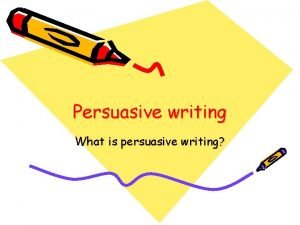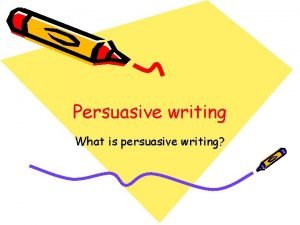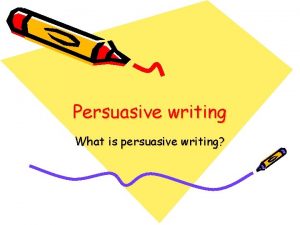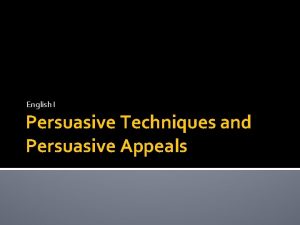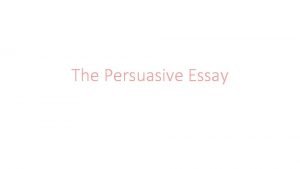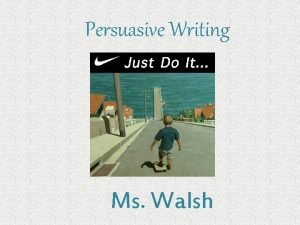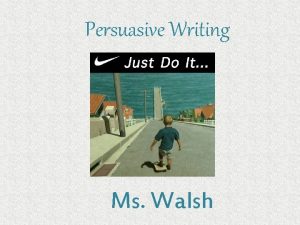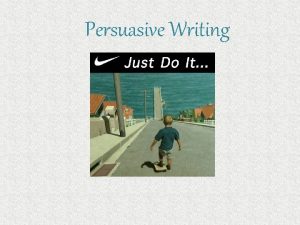Speaking to Persuade Persuasive Speech A speech designed









































- Slides: 41

Speaking to Persuade 常姗姗 上海财经大学

Persuasive Speech A speech designed to change or reinforce the audience’s beliefs or actions.

Speech to Gain Immediate Action The speaker’s goal is to convince the audience to take action. 1. 2. To change things from the status quo Or NOT to change things from the status quo

Informative and Persuasive Speech Differences: Informative Speech Persuasive Speech To increase knowledge To change mind or action Message’s Purpose To define, describe, explain, compare Listener’s Effect To know more than before, to advance what is known To shape, reinforce, change audience responses To feel or think differently, to behave or act differently Audience Choice To willingly learn new knowledge To change behavior by choice Speaker’s Intent

The nature of persuasive speeches

When creating a persuasive message ¾ Consider context ¾Time limit ¾Environment ¾Expectations of audience

Speaking to Persuade influencing of the attitudes, beliefs, or behavior of the listeners. • Given when two or more points of view are in conflict about a topic • To be or not to be?

Four keys to effective persuasion ¾ A. ¾ B. ¾ C. ¾ D. Credibility Well-reasoned argument Emotion Audience involvement

It is more difficult than speaking to inform. It demands additional skills. Examples: political figures, lawyers, legislators, speaking to PTO, city council

The nature of a persuasive speech: Strategic discourse

Persuasive speeches deal with three different questions: ¾ Questions of fact ¾ Questions of value ¾ Questions of policy

The nature of a persuasive speech: Fact, value, or policy claims

Question of Fact A question about the truth or falsity of an assertion.

Persuasive Speech--Question of Fact Specific Purpose: To persuade my audience that cigarette smoking causes serious health dangers. Central Idea: There is overwhelming evidence that cigarette smoking causes serious dangers to human health. Main Points: I. II. Studies in China show that cigarette smoking is a major cause of cancer, tuberculosis, (肺结核)and heart disease. Scientists estimate that half of today’s smokers in China will eventually be killed by tobacco.

üQuestions of fact: occurrences and the reasons that they have happened, are happening, or will happen in the future. ü e. g. Is there intelligence life elsewhere in the universe? ü Do UFOs really exist?

¾ If you state a fact claim then prove that your claim is the best. ¾ Why do I think something is true or false? ¾ Provide evidence, hard facts, statistics, new figures, illustrations, quotations, definitions.

ü Questions of value: call for judgments about right and wrong, ethical and unethical, etc. Value claim: Persuade the public that trial marriage is right/wrong. Persuade the public that animals don't belong in zoos. Is animal experimentation ethical?

Value of Claim ü If you state a Value Claim then appeal to the morality and values of your listeners. ü Why do I like or dislike something? ü Why do your listeners have to agree that something is right or wrong, moral or immoral, valuable or worthless? ü Why do you want to convince them? ü Offer examples the public will recognize, try to find common ground on related subjects and expert testimonies, and compare your idea with oppositional ideas.

Question of Value A question about the worth, rightness, morality, and so forth of an idea or action.

Persuasive Speech--Question of Value Purpose: To persuade my audience that bicycle riding is the ideal form of land transportation. Central Idea: Bicycle riding is faster than walking or running, is nonpolluting, and promotes the health of the riders. Main Points: I. II. An ideal form of land transportation should meet three major standards. Bicycle riding meets all these standards for an ideal form of land transportation. punishment. ”

üQuestions of policy: deal with whether certain courses of action should be taken. Policy claim: Persuade the public that Consenting people should/should not be legalized to get married. To persuade my audience that our city should begin a mandatory recycling program.

Question of Policy A question about whether a specific course of action should or should not be taken.

Policy Claim ü If you state a Policy Claim then persuade that there is a problem and get the audience to agree with your solution. ü Appeal to human needs, to reason and to emotion. ü Summarize the present situation, the causes and the negative effects everybody will recognize. ü Then present your solution to solve the problem.

Policy ¾ To persuade my audience to vote in the next presidential election. ¾ To persuade my audience that there should be tougher enforcement of laws to protect the victims of domestic abuse.

Specific purpose: to persuade my audience that the use of antibacterial chemicals in household products should be reduced. ¾ Central idea: the use of antibacterial chemicals in household products is a serious problem that requires action by government and consumers alike. ¾ Main points: 1. rather than making us healthier, antibacterial chemicals in household products are creating long-term health problems. ¾ 2. solving these problems requires a combination of government regulation and consumer action.

When creating a persuasive message ¾ Consider audience ¾Demographics ¾Knowledge of topic ¾Attitude toward topic

Degrees of Persuasion Strongly Opposed Moderately Opposed Slightly Opposed Neutral Slightly in Favor Moderately in Favor Strongly in Favor Persuasion involves any movement by a listener from left to right

Persuasive speaking: Framing your argument based on audience

Maslow’s Heirarchy of Needs: biological drives (food, drink, air, sleep, etc. ) ¾ safety (security, stability, protection from harm, structure, predictability) ¾ love and belonging (affection, feeling part of a social group, acceptance and approval, etc. ) ¾ esteem (confidence, freedom, independence, recognition by others, etc. ) ¾ self-actualization (self-fulfillment, realizing individual potential, being true to self, etc. ) ¾

Incorporating persuasive strategies: Relate main and supporting points to your audience Appealing to your audience’s needs ¾ Maslow’s hierarchy of needs: basic-level needs must be met before higher-level needs become important. ¾

If you can relate your message to your listener’s various needs, you are more likely to persuade them.

Incorporating persuasive strategies: Relate main and supporting points to your audience ¾ Demonstrate how audience benefits ¾Help listeners visualize benefits gained if they take the actions you are advocating. ¾Listeners weigh costs and benefits before responding to your persuasive appeal

Incorporating persuasive strategies: Relate main and supporting points to your audience

1. Get attention of audience 2. Establish a need 3. Satisfy that need 4. Visualize the future 5. Ask for action

Monroe’s motivated sequence ¾ Introduction = Attention ¾ Main point 1 = Need ¾ Main point 2 = Satisfaction ¾ Main point 3 = Visualization ¾ Conclusion = Action

Monroe’s motivated sequence --ATTENTION ¾ Attention: Get audience’s attention, arousing curiosity about what the speaker is going to say.

Attention Functions ¾ To gain attention ¾ To secure good will and respect (your credibility and why audience should listen/care) ¾ To prepare the audience for discussion of your topic ¾ To help avoid the effects of psychological reactance, the preview statement should be omitted.

Methods ¾ ¾ ¾ ¾ Reference to a subject, event, or occasion Personal greeting Rhetorical question Startling statement/statistics Quotation Humorous anecdote Illustration Appeal to needs

Organize your persuasive speech: Policy claims ¾ Use a motivated sequence pattern that uses the following five steps: ¾Attention ¾Need ¾Satisfaction ¾Visualization ¾Action

Organize your persuasive speech:

In class activity ¾ Overseas returnees should have preferential access to employment. ¾ Honesty is the best policy.
 Chapter 16 speaking to persuade
Chapter 16 speaking to persuade Persuasive speech vs informative speech
Persuasive speech vs informative speech Informative vs persuasive speech
Informative vs persuasive speech The art of speaking or writing effectively
The art of speaking or writing effectively Persuasive presentation definition
Persuasive presentation definition Rhetoric: the art of persuasive writing and public speaking
Rhetoric: the art of persuasive writing and public speaking Rap lyrics on trial ethos pathos logos
Rap lyrics on trial ethos pathos logos Value persuasive speech
Value persuasive speech Persuade reported speech
Persuade reported speech Reported speech persuade
Reported speech persuade Monroe's motivated sequence
Monroe's motivated sequence What is persuasive speech
What is persuasive speech Definition of persuasive speech
Definition of persuasive speech Persuasive speech conclusion
Persuasive speech conclusion What is persuasion
What is persuasion Persuasive speech on buying a house
Persuasive speech on buying a house Warrant in persuasive speech
Warrant in persuasive speech Problem cause solution persuasive speech
Problem cause solution persuasive speech Persuasive speech problem solution
Persuasive speech problem solution Summer holiday paragraph
Summer holiday paragraph Organizing your presentation
Organizing your presentation Persuasive speech on tattoos
Persuasive speech on tattoos Comparative advantage persuasive speech
Comparative advantage persuasive speech Informative vs persuasive speech
Informative vs persuasive speech Persuasive text about scotland
Persuasive text about scotland How to organize a persuasive speech
How to organize a persuasive speech Persuasive speech techniques
Persuasive speech techniques Persuasive speech thesis
Persuasive speech thesis How to write a hook for a persuasive speech
How to write a hook for a persuasive speech Specially designed
Specially designed A series of steps designed to solve a problem
A series of steps designed to solve a problem Universally designed allowances
Universally designed allowances Who designed futura
Who designed futura Alfred binet designed the first ______ test.
Alfred binet designed the first ______ test. Electronic device designed to accept data
Electronic device designed to accept data A program designed to send your advertisements, pop-ups
A program designed to send your advertisements, pop-ups Asynchronous counter
Asynchronous counter Designed for life primary care
Designed for life primary care In 1864 george pullman designed
In 1864 george pullman designed What is commercial data processing
What is commercial data processing The basic activities in the glars are
The basic activities in the glars are An internet is a collection of utility programs designed
An internet is a collection of utility programs designed
